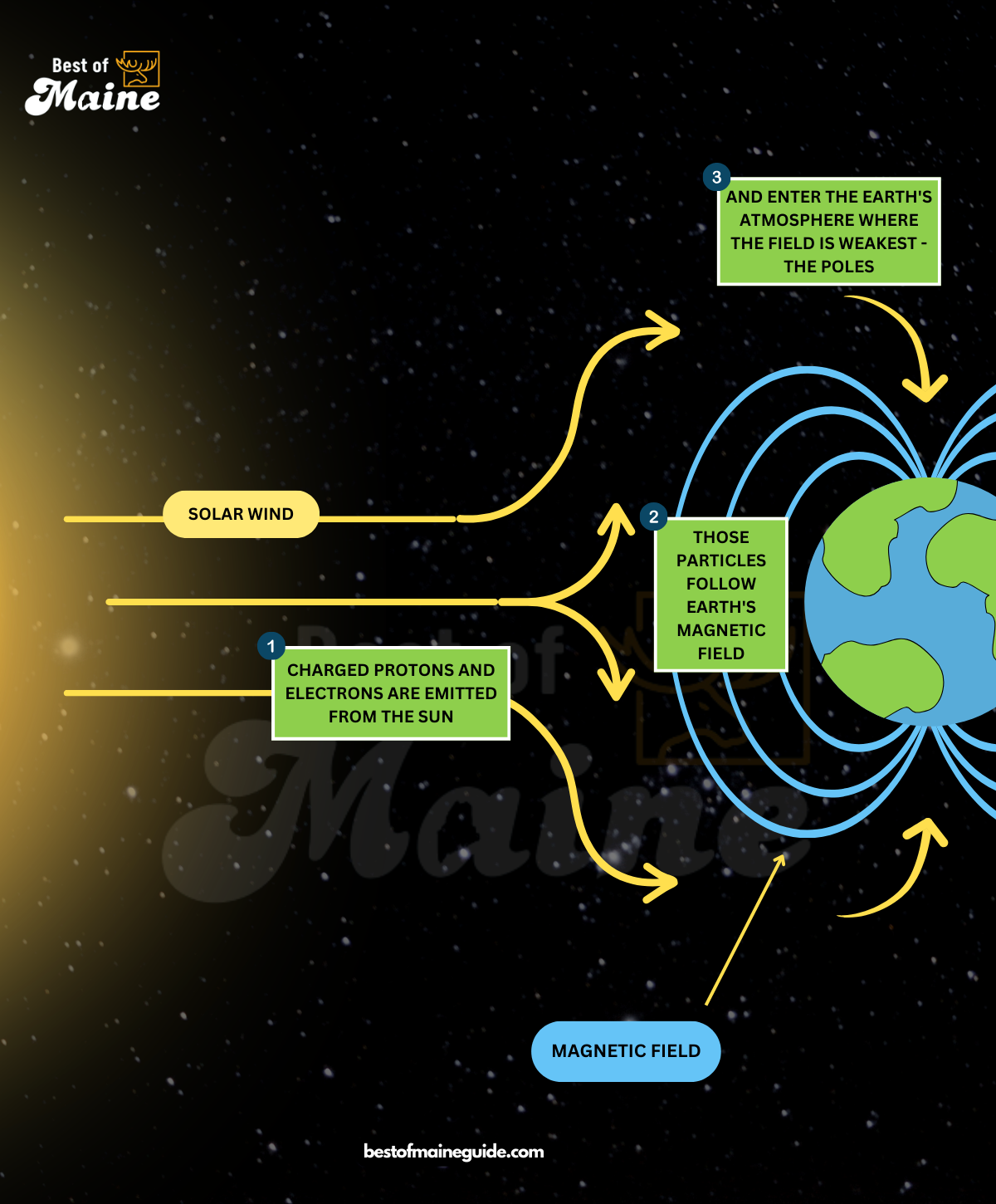Aurora Borealis in Maine: A Complete Guide to the Northern Lights
Have you ever wanted to see the sky light up with magical colors? The Aurora Borealis, or Northern Lights, is one of nature’s most incredible shows. And the best part? You can see it right here in Maine!
This guide is all about helping you plan the perfect trip to witness the Northern Lights in Maine, where the skies are dark and the natural beauty is out of this world. From the best times of the year to top places for viewing, we’ve got you covered. Ready for a sky full of wonder? Let’s dive in!
Key Highlights
Best time: Fall and winter (September to March).
Top spots: Aroostook County, Baxter State Park, Acadia.
Best hours: Between 10 p.m. and 2 a.m.
Stay Tips: Camping is the best way to stay close to the action.
Northern Lights in Maine: Expert Tips
To get the best view, head as far away from artificial lights as you can. Areas like Aroostook County and Katahdin Woods are perfect for seeing the northern lights in Maine in 2024 because they are far from towns and cities. Even in Acadia or Moosehead Lake, find a spot where trees or mountains block any nearby lights.
What you’ll read about
What is the Aurora Borealis?
A Simple Science behind Aurora Borealis (Northern Lights)
It is a light show created when particles from the sun hit Earth’s magnetic field. It sounds complicated, but the image below will definitely help you understand.
This image illustrates how the Northern Lights (Aurora Borealis) are formed:
- Solar Wind: Charged particles, such as protons and electrons, are emitted from the Sun as part of the solar wind.
- Magnetic Field: These particles are guided by Earth’s magnetic field as they approach the planet.
- Interaction at the Poles: The particles enter Earth’s atmosphere near the poles, where the magnetic field is weakest. As they collide with gases in the atmosphere, they produce the colorful display known as the Northern Lights.

What Makes the Northern Lights So Colorful?
The lights can be green, purple, or even red, and they dance across the sky, leaving everyone below in awe. It’s like nature’s very own fireworks, only better because it’s all natural!
In Maine, where the skies are dark and wide open, you can get a front-row seat to this magical performance ;). Ever wondered where the colors in the northern lights come from? Check out this simple image to understand.
This image explains how the colors of the Northern Lights are created. When electrons from the solar wind collide with molecules in Earth’s atmosphere, the energy from these collisions excites the molecules, producing different colors. The specific altitude and type of gas molecule determine the colors of the aurora that we see in the sky.

Why is Maine an ideal location for the Northern Lights?
Maine is one of the best places in the U.S. to see the Northern Lights.
- It’s located far enough north, meaning you have a higher chance of seeing the lights.
- Plus, Maine has lots of remote spots with little to no light pollution.
- The darker the sky, the better the view!
- Areas like Aroostook County, Baxter State Park, and Moosehead Lake are top picks because they offer wide-open skies and a peaceful, quiet setting to enjoy the show
When Can You See the Northern Lights in Maine?
Best Time to See the Northern Lights in Maine
The best time to see the aurora borealis in Maine is from September to March, during the fall and winter months. Why? Because the nights are longer and darker, giving the lights more time to shine. Cold, clear nights are perfect for aurora viewing, especially when the skies are clear. It may be chilly, but bundle up—it’s totally worth it! Late night to early morning, especially between 10 p.m. and 2 a.m., offers the best chances.
Summary
- Weather Tips: Important weather factors to keep in mind (Clear skies, minimal cloud cover)
- Best months: Fall and Winter
- Times of day: Night and early morning hours for northern lights in Maine
Best Places to See the Northern Lights in Maine
1. Aroostook County
Why it’s the top destination in Maine
Aroostook County is at the top of the state, making it one of the northernmost spots you can go to in Maine. This means it’s perfect for aurora viewing, with dark skies and plenty of wide-open spaces. Because it’s so far from city lights, the skies are incredibly clear, making it one of the best places in the entire U.S. to catch the lights.
Best viewing locations in Aroostook County
Some of the best places to set up camp for aurora watching in Aroostook County include Caribou, Presque Isle, and Fort Fairfield.
- These towns offer easy access to dark, quiet areas where you can settle in for the night and wait for the lights to appear.
- Many locals will tell you that heading a bit further into the countryside gives you even better views.
Insider tips
– Aroostook State Park is a favorite among locals.
– It’s quiet, and you can camp there to stay close to the action.
If you want even more solitude, try Haystack Mountain—a short hike will give you stunning panoramic views.
2. Baxter State Park
Why it’s the top destination
Baxter State Park is famous for its wild beauty, but it’s also a great place to see the Northern Lights. The park is far from any big town, so light pollution is minimal. Plus, the park’s mountainous landscape adds a whole new level of beauty to your aurora-watching experience.
Best spots inside the park
To catch the best views in Baxter State Park, head to spots like Daicey Pond or South Branch Pond.
- These areas are tucked away, giving you plenty of quiet and dark skies for aurora-watching.
- There are also cabins and campgrounds nearby, so you can stay overnight and increase your chances of seeing the lights.
Insider tips
Camping is one of the best ways to see the Northern Lights at Baxter State Park.
3. Katahdin Woods and Waters National Monument
Why it’s one of the most pristine spots
If you’re after a truly untouched wilderness experience, Katahdin Woods and Waters National Monument is where you want to go. It’s one of the most remote and pristine areas in Maine, and because it’s so far from any light pollution, the skies are incredibly dark. That makes it one of the best places in Maine to see the Northern Lights.
Best places to camp in Katahdin Woods and Waters National Monument
To make the most of your trip, camping is the way to go.
- Campsites within Katahdin Woods and Waters offer some of the darkest skies you’ll find in Maine.
- Set up camp, sit back, and let nature put on the show.
Insider tips
The quiet, remote location means you’re likely to have the place almost to yourself, making it feel even more magical when the lights start to dance.
4. Acadia National Park
Can you see the northern lights in Maine at Acadia?
Yes, sometimes! Acadia National Park is one of Maine’s most popular destinations for its stunning ocean views, but did you know you can sometimes catch the Northern Lights here too? While it’s not as far north as places like Aroostook or Baxter, the combination of dark skies and incredible scenery means you can still spot the aurora on the right night.
Best spots to see Northern Lights in Acadia
If you’re visiting Acadia and hoping to see the Northern Lights, head to Cadillac Mountain or Seawall.
- These areas offer wide, open views of the sky and are far enough from the lights of nearby towns.
- Cadillac Mountain is particularly famous for its panoramic views, so if you time it right, you can enjoy both the sunrise and the aurora!
Acadia with a beautiful aurora borealis light show photo via @acadianps
Insider tips
To increase your chances of seeing the Northern Lights in Acadia, check the aurora forecast before you go. Plan your visit around a night with clear skies and minimal cloud cover.
Aurora Forecast
If you need help where to look for the Northern Lights, consider checking out the National Oceanic and Atmospheric Administration (NOAA) Space Weather Prediction Center. They have a 30-minute Northern Lights forecast showing where and how strong the aurora will be. Additionally, light pollution maps can be useful for identifying areas with less light pollution, which can improve your chances of spotting the Northern Lights.
(Camera, tripod, lenses)
Tips for Photographing the Northern Lights
What gear do you need to photograph the aurora borealis in Maine?
Capturing the Northern Lights on camera is a must, and while you don’t need fancy equipment, a few basics will make a huge difference.
- A camera with manual settings is best, along with a sturdy tripod to keep your shots steady.
- You’ll also want a wide-angle lens (something like 10-24mm) to capture as much of the sky as possible.
Tip: Don’t forget extra batteries—cold weather drains them faster than you’d expect.
(Here are some simple tips!)
How to set up your camera for perfect shots of the northern lights in Maine
Getting the perfect shot of the Northern Lights doesn’t have to be tricky.
- First, switch your camera to manual mode so you can control the settings.
- Set your ISO to around 1600-3200, and use a long exposure (try starting with 10-20 seconds).
- Keep your aperture wide open (f/2.8 or lower) to let in as much light as possible.
- It might take a little experimenting, but with these settings, you should get some great shots!
(ISO, shutter speed, etc.)
Best settings for capturing the northern lights
For ISO, start at 1600 and go up if needed.
- Your shutter speed depends on how bright the aurora is, but start with around 10-20 seconds—just long enough to capture the movement but not so long that the aurora blurs.
- Your aperture should be set to the lowest number possible (f/2.8 or lower).
- These settings will help you capture the aurora’s brightness and movement.
No professional camera?
What to do if you’re using a smartphone
No professional camera? No problem! You can still capture the Northern Lights with your smartphone.
- First, make sure you have a tripod or set your phone on a steady surface.
- Some phones have a manual mode where you can adjust the exposure time and ISO—use those settings to make sure the camera takes in enough light.
If your phone doesn’t have those options, there are apps (like NightCap for iOS) that will help you get those stunning Aurora shots!
Wrapping up
Remember, patience is key when it comes to aurora hunting. Even if the lights don’t show up, you’ll still be treated to some of the most beautiful dark skies in the country. So pack your bags, grab your camera, and get ready for a magical night under the Maine stars. Who knows? You might just catch the show of a lifetime. Happy Aurora hunting!
FAQs About Seeing the Northern Lights in Maine
How often can you see the northern lights in Maine?
It varies, but during peak solar activity, you might catch them several times a month in winter.
Do I need special equipment to see the aurora?
Nope! Just your eyes and a clear, dark sky. But binoculars can enhance the experience.
Can I see the northern lights in summer in Maine?
It’s possible but rare due to the shorter, lighter nights.
How long do the northern lights typically last?
Displays can last from a few minutes to several hours.
